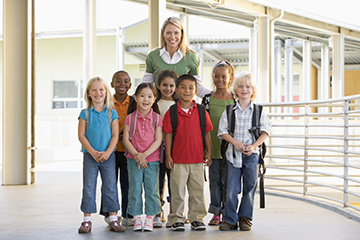How We Learned The Rules Of Behaviors
How tin teachers help young children learn expected behaviors?
Page 2: Agreement Behavior Expectations and Rules
 For virtually young children—that is, those ages three to v—school is a circuitous and novel setting. Educators should non simply presume that young children volition intuitively understand the expectations of this new environment. Rather, early childhood teachers need to be prepared to support and promote appropriate behavior. When children understand what is expected of them, they are more than likely to brandish advisable behavior. Thus, it is important for teachers to establish behavior expectations and rules as function of the overall classroom behavior management system. Beliefs expectations and rules are important for immature children because they explicitly describe how to deport.
For virtually young children—that is, those ages three to v—school is a circuitous and novel setting. Educators should non simply presume that young children volition intuitively understand the expectations of this new environment. Rather, early childhood teachers need to be prepared to support and promote appropriate behavior. When children understand what is expected of them, they are more than likely to brandish advisable behavior. Thus, it is important for teachers to establish behavior expectations and rules as function of the overall classroom behavior management system. Beliefs expectations and rules are important for immature children because they explicitly describe how to deport.
Behavior Expectations
Sample Beliefs Expectations
- Be safe
- Be responsible
- Exist respectful
Although the terms behavior expectations and rules are frequently used interchangeably, they actually refer to dissimilar things. Behavior expectations tin can exist defined equally broad goals for beliefs or the full general means that teachers would like children to deed. They serve as guidelines for behavior and apply to all children across all settings. In add-on, beliefs expectations apply to the adults in these settings.
Ideally, behavior expectations are developed for the unabridged school or centre and are used as a framework for helping teachers to establish rules and provide guidance to children. Because behavior expectations are oftentimes broad concepts and somewhat abstract for very immature children, teachers should create rules to help analyze their significant as they are applied within specific activities and contexts. Teachers who work in centers where such expectations are not in place can yet establish rules and expectations to guide children's behavior.
Rules
By contrast, rules define the appropriate behaviors that educators want children to demonstrate. These behaviors should exist concrete, observable, and measurable. Rules might vary depending on the setting (east.g., classroom, lunchroom, outside). Teachers can use a matrix to specify the explicit rules that reflect each behavior expectation. A matrix tin be used to maintain continuity across settings when appropriate and to clarify for children how beliefs expectations volition vary in different settings. For case, consider how the expectation "Be safe" tin be defined in various settings. In the classroom and in the hallway, "Be safe" translates into the rule "Use walking feet." Still, on the playground, "Utilize walking anxiety" is not a requirement; instead, "Sit on bikes, slide, and swings" is a more advisable rule.
The matrix below illustrates how some behavior expectations can be translated into rules for the classroom, playground, and hallway.
| Beliefs Expectation | Classroom Rules | Playground Rules | Hallway Rules |
| Be safety |
|
|
|
| Be responsible |
|
|
|
| Exist respectful |
|
|
|
Listen equally Amanda Peirick and Mary Louise Hemmeter hash out the differences betwixt behavior expectations and classroom rules. Mary Louise Hemmeter further explains how establishing behavior expectations and rules can help forestall problem behaviors earlier they happen.

Amanda Peirick, MEd
Lead Teacher, Susan Grey School
Nashville, TN
(time: ane:30)

ML Hemmeter, PhD
Professor, Special Education
Co-Faculty Managing director of the Susan Grey School for Children
Vanderbilt University
(time: one:08)
Transcript: Amanda Peirick, MEd
When I call up about beliefs expectations, I call back virtually these sort of broad or general goals that nosotros accept. These are things that really transcend every activity that we're doing throughout the school environment. So information technology's things similar being respectful, being responsible, being prophylactic. 1 of the ones we accept at our school is existence a team player. There's these wide concepts that organize what positive behaviors we want to have. When I retrieve about rules, I remember about specific behaviors that autumn under these things. At the schoolhouse I work, our whole schoolhouse has these expectations, and and then I sabbatum down with my kids and I thought almost, all right, responsible doesn't really feel very meaningful for them. What tin can nosotros do to teach them what being responsible looks like in our classroom? Nosotros came up with some more specific rules, like use your walking feet, use your quiet vocalism, or your nice words, use your gentle touches. Those were our classroom rules, and and so they had really physical images of what it meant to be a team player, to be safe in the school environment.
I think that the benefit of having a classroom where these rules and expectations are pervasive throughout everything you do is that kids know what to expect. They know what they're supposed to be doing. Generally, when yous give kids the chance to do what they're supposed to be doing, do what y'all've asked them to do, what positive behaviors you've told them to exercise, they're going to choose to do that rather than something that is a more challenging behavior. Creating these environments really just helps kids know what to do and what to wait.
Transcript: ML Hemmeter, PhD
More often than not, we call up expectations are broader statements near what we want children to do. They might be something like: Be safe, be a team player, be a friend, be kind, be responsible, exist respectful. Just when y'all think about three, iv, and five-years-olds who aren't going to know what it means to be safe, be respectful, be responsible, the rules are more specific behaviors that would be tied to those expectations. So if we had an expectation that would "exist responsible," some of the rules might be "clean up your toys after yous play with them" and that mode to exist responsible. Or if one of your expectations is to "be a team actor" then one of the rules might exist "we aid our friends." If your expectation is to "be safe" then we might say "nosotros make clean up our toys so children don't trip on them." The rules are actually the specific behaviors that would be associated with the more broad general statement, which is the expectation.
For Your Data
It is important for teachers to recognize the function that culture plays in behavior when they establish classroom expectations. For example:
- The acceptability of beliefs is often culturally determined. Behaviors such every bit talking while another is talking, calling out in response to a question, making eye contact, and many other behaviors are heavily influenced by culture.
- When at that place is a mismatch between the civilisation of a child and the culture of the teacher, the instructor might perceive the child's behavior as challenging.
- Expectations and rules tin help children to crack the code almost the different ways to behave in unlike settings.
- It is critical to focus on respect and relationships with all children. Adults should monitor their ain behavior to brand sure they are responding to children fairly and consistently.
Revisit Mrs. Rodriquez's Classroom
 Mrs. Rodriquez has never really thought about trying to marshal her classroom rules with the behavior expectations of her schoolhouse. She likes the idea of using the school-broad behavior expectations ("We are safe," "We are team members," and "We are respectful") as a framework for developing rules for her classroom and other areas of the school. She wonders how she tin do that and whether it will make a divergence in how her children follow the classroom rules.
Mrs. Rodriquez has never really thought about trying to marshal her classroom rules with the behavior expectations of her schoolhouse. She likes the idea of using the school-broad behavior expectations ("We are safe," "We are team members," and "We are respectful") as a framework for developing rules for her classroom and other areas of the school. She wonders how she tin do that and whether it will make a divergence in how her children follow the classroom rules.
Source: https://iris.peabody.vanderbilt.edu/module/ecbm/cresource/q1/p02/
Posted by: whitelottly.blogspot.com


0 Response to "How We Learned The Rules Of Behaviors"
Post a Comment